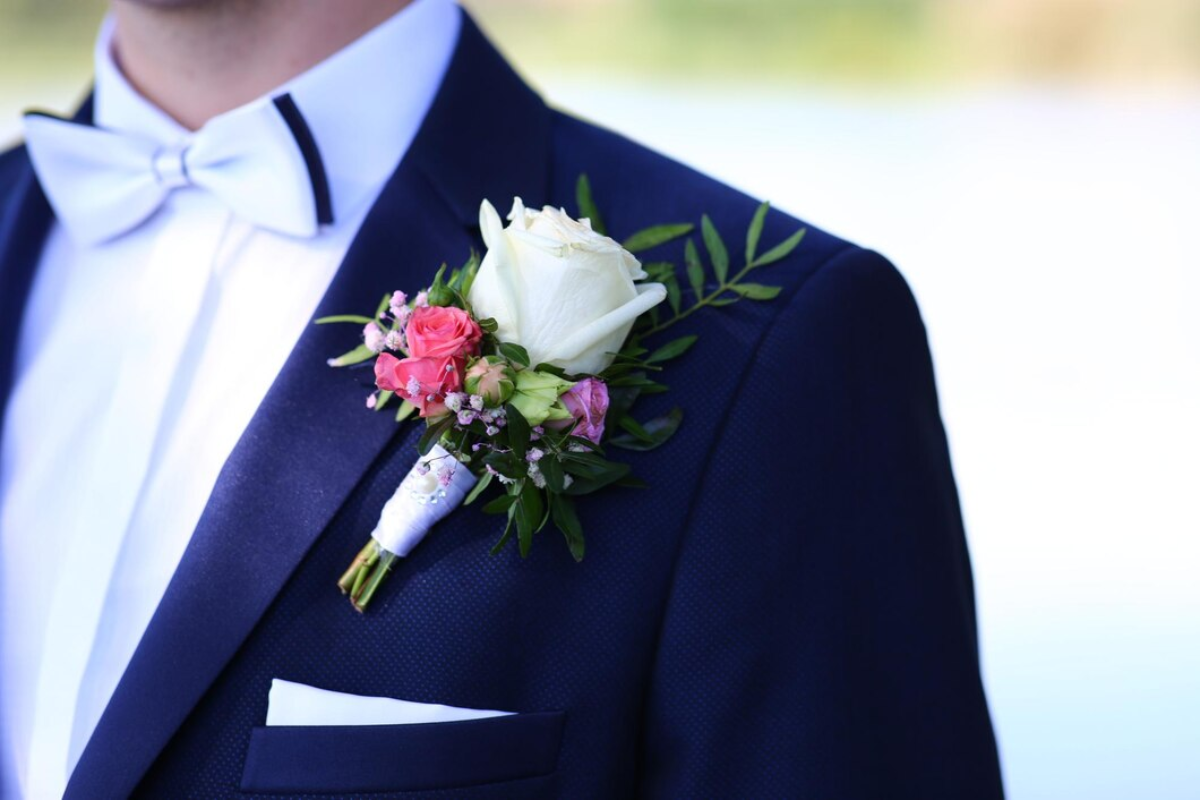A boutonniere is a small, charming floral accessory typically worn on the lapel of a suit or tuxedo. It’s a timeless touch that adds elegance to any formal outfit, especially at weddings, proms, and other special occasions. Though simple in appearance, the boutonniere carries tradition, style, and symbolism. In this guide, you’ll learn all about what a boutonniere is, the different types available, how to choose one, and how to wear and care for it with confidence and ease.
What Is a Boutonniere?
The word “boutonniere” comes from the French term for “buttonhole flower.” Traditionally, it refers to a small floral decoration worn on the left lapel of a suit or tuxedo. Historically, men wore boutonnieres as symbols of honor, bravery, and romance. They were often seen at military parades and formal gatherings, representing elegance and status.
Over time, the boutonniere became a popular feature at weddings and proms. Today, it’s mostly worn to celebrate important life events. Whether you’re a groom, prom date, or part of a graduation ceremony, a boutonniere adds a stylish and meaningful detail to your look. While fashion trends change, the classic charm of a boutonniere remains relevant across generations.
Popular Types of Boutonnieres
Boutonnieres come in many different styles, allowing you to match them to the tone and formality of the event.
Fresh Flower Boutonnieres
The most traditional type is made with fresh flowers. Common choices include roses, carnations, orchids, or even small sprigs of lavender or baby’s breath. These boutonnieres are often selected to match the event’s color theme or coordinate with the bride’s bouquet.
Dried and Artificial Options
If you’re looking for something long-lasting or allergy-friendly, dried or artificial boutonnieres are great alternatives. Dried flowers, preserved greenery, or silk versions can be just as beautiful. They are ideal for hot weather events or destination weddings where fresh flowers might not hold up well.
Themed or Custom Designs
For events with specific themes or personal flair, customized boutonnieres are becoming more popular. You might see miniature guitars, feathers, paper flowers, or even small pins and badges mixed in with floral elements. These designs are perfect for expressing personality while keeping a formal touch.
How to Choose the Right Boutonniere for Any Event?
Selecting the right boutonniere depends on the nature of the event, your outfit, and the season. For weddings, it’s best to coordinate with the overall color palette and floral arrangements. Grooms, groomsmen, and even fathers of the bride or groom often wear boutonnieres that complement the bridal bouquet or wedding theme.
When it comes to proms or formal dances, the boutonniere should complement your date’s attire or corsage. Choosing a color that matches or blends with the dress can make a cohesive and polished appearance.
Consider the time of year as well. In spring or summer, light flowers like daisies or roses work well. For fall or winter events, sturdier blooms or even rustic elements like pinecones or berries can look more appropriate. The goal is to keep it simple, tasteful, and in harmony with the rest of your outfit.
How to Properly Wear a Boutonniere?
Wearing a boutonniere may seem straightforward, but small details can make a big difference. Here’s how to ensure it looks right and stays secure.
Where to Place the Boutonniere on a Jacket?
A boutonniere is typically placed on the left lapel of a jacket, over the heart. Most suit jackets have a buttonhole in this spot, which was originally made specifically for a boutonniere. Some jackets also have a small fabric loop behind the lapel to keep the stem in place.
If the lapel doesn’t have a buttonhole, don’t worry. You can still wear a boutonniere by pinning it neatly in the correct position.
Pinning Tips for a Secure and Clean Look
Use a sturdy pin or two to attach the boutonniere securely from behind the lapel. Angle the pin upward through the stem and fabric to keep the flower in place without making it too noticeable. Avoid sticking the pin through the front of the lapel, as it can damage the fabric and spoil the clean look.
Make sure the flower is upright and not leaning to one side. A tilted boutonniere can look sloppy, even if everything else is perfect.
Mistakes to Avoid When Wearing One
Avoid wearing a boutonniere with a pocket square that competes for attention. Keep your look balanced. Also, don’t go overboard with size—smaller flowers are usually more refined and elegant. Overly large or heavy boutonnieres can sag or even fall off during the event.
Make sure the boutonniere matches the tone of the occasion. Bright or playful flowers might be fun for a casual event but may not suit a formal or black-tie setting.
Caring for and Preserving a Boutonniere
A fresh boutonniere needs a bit of care to stay looking its best throughout the event. Try to refrigerate it until it’s time to wear it. Keep it away from direct sunlight and heat, as this can cause it to wilt quickly. If you’re wearing it outdoors, be mindful of wind and humidity, which may affect its appearance.
After the event, some people choose to preserve their boutonniere as a keepsake. Drying the flower upside-down in a cool, dark space is a common method. Alternatively, pressing the flower in a book or using silica gel can help maintain its shape and color. Artificial boutonnieres are easier to keep and can be stored safely without much effort.
Whether fresh or faux, storing your boutonniere in a small display box or shadow frame can help you cherish the memory of a special day for years to come.
Conclusion
A boutonniere is more than just a decorative flower—it’s a symbol of style, tradition, and celebration. From selecting the right type to learning how to wear and preserve it, understanding this small detail can have a big impact on your formal outfit. Whether you’re attending a wedding, prom, or any event worth dressing up for, a boutonniere adds that perfect finishing touch. With a bit of thought and care, anyone can wear one with confidence and grace.
FAQs
1. Can I wear a boutonniere without a jacket?
Yes, but it’s less common. If you do, consider pinning it to a vest, shirt, or suspenders. Just make sure it fits the formality of the outfit and occasion.
2. How long does a boutonniere last?
A fresh boutonniere typically lasts about 12 to 24 hours, depending on the flower type and how it’s cared for. Artificial or dried ones can last indefinitely with proper storage.
3. What side should a boutonniere be worn on?
Traditionally, it is worn on the left lapel, directly over the heart. This placement is both symbolic and stylistically standard.
4. Are boutonnieres only for weddings?
No. While weddings are the most common event for boutonnieres, they are also popular at proms, graduations, memorial services, and other formal gatherings.
My name is Mustafa, and I have been blogging for over 5 years. I am passionate about sharing complete, accurate, and helpful information with my readers. Along with managing content on The Matcha Read, I also contribute blog posts to premium websites. My goal is to provide valuable insights in a clear and easy-to-understand way, so every reader walks away with useful knowledge.










